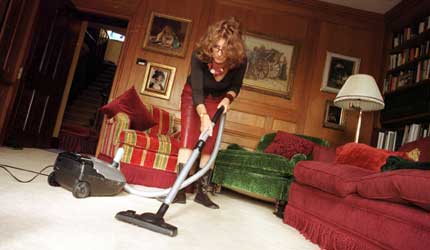
What's in Anita Roddick's carpet? What poisons lurk in your home?
Greenpeace has published a scientific investigation into toxic chemicals in house dust, revealing their widespread presence in homes across the UK. In November 2002, Greenpeace vacuumed 100 houses across the country to collect dust that was later sent to laboratories to be analysed for a range of harmful pollutants, "Chemicals of Very High Concern"
The dangerous chemicals Greenpeace targeted for investigation were not those coming from traffic fumes or factory chimneys but unseen and often unlabelled chemical additives brought into our homes inside everyday consumer products like toys, televisions, carpets and toiletries.
The majority of chemicals that have been identified in house dust arise from the use of consumer goods used in the home. This is despite some manufacturers' claims that these chemicals are bound into products and present no risk. Humans can breathe in the dust and any chemicals it contains or ingest it from contaminated food or teething toys or even absorb it directly through our skin.
This report exposes the fact that widespread chemical contamination is not just there in the 'outside world' but in our homes, our offices and everyday lives. We know that chemical pollution can find its way into their homes from busy roads or dirty factories but do not expect unseen poisons to be escaping into our bedrooms and living rooms from every day products like toys and televisions. From there they can contaminate our body tissue and the tissue of unborn children.
Greenpeace found substantial amounts of
- hormone disrupting akylphenols, used in cosmetics and other personal care products
- phthalate esters used mainly to soften PVC which are harmful to the reproductive system,
- brominated chemicals which disrupt hormones, used as fire retardants
- chlorinated paraffins which may be cancer-causing, used in paints, plastics and rubbers.
After establishing the presence of these chemicals in everyday products, then finding the same ones in housedust, we have now looked in detail at the human body, finding that these chemicals are being absorbed from products and the environment into our body fat and major organs.
It is clear that urgent action is needed to take toxic chemicals out of the goods we use to safeguard our health.
New laws currently being drafted by the EU present a rare opportunity to improve legislation on chemicals, which for years has failed to protect people and the environment from contamination.
The proposed new EU laws require that chemicals of the highest concern carry an 'authorisation' to allow only specific continued uses. Greenpeace supports this but believes this action is meaningless unless a second step is put in place - chemical producing companies must be placed under a legal obligation to substitute these chemicals of high concern wherever a safer alternative exists. Where an alternative does not exist and the chemical is deemed essential, an authorisation must only be granted for a limited time period to allow for safer alternative chemicals, material or products to be developed.
Take a look at the results of the housedust survey Consuming Chemicals
We have also produced a report which looks in depth at the principle of substitution the Substitution Report

